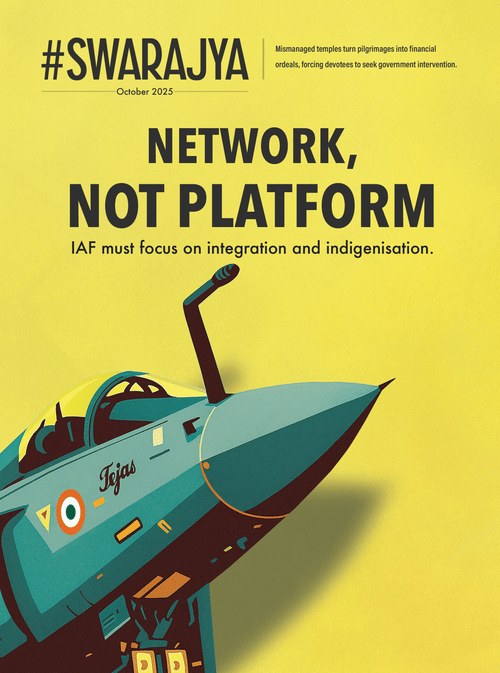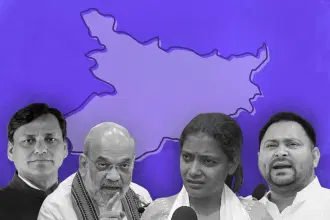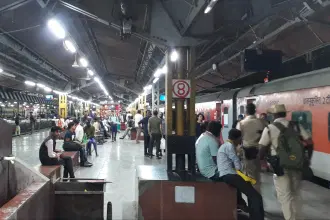Legal
Stray Dogs, SIR, And More: Is The Supreme Court Cosplaying As A Supra-Constitutional Entity?
Harsh Anmol and Ananth Krishna
Aug 29, 2025, 01:51 PM | Updated 01:50 PM IST
Save & read from anywhere!
Bookmark stories for easy access on any device or the Swarajya app.


A spate of recent Supreme Court decisions have brought into attention a theme highlighted time and time again: that of excessive judicial overreach and interference. This theme is of course not new, and anyone with even a slightly sceptical view of the courts and the legal system in the country have waxed eloquent about it online.
Yet, the Court needs to be reminded in some shape or another that what it does as a regular course of business is not normal in other democracies. It has become routine, normal and unquestioned so much so that many basic matters failed to get mentioned in opinion pieces in the 'national' newspapers.
Our intelligentsia and to an extent, our people have accepted or adjusted or cheered the reality of judicial oversight in virtually every sphere.
The Supreme Court in the last week for example, issued sweeping, nation-wide directions on stray dogs and also issued a sweeping direction to a constitutional authority i.e., the Election Commission of India (ECI) on how it should undertake its duties. The Supreme Court has become a Supra-Constitutional entity whose whims and diktats are only held back by itself.
The Stray Dogs Case As Symptomatic Of Overreach
Let us take the issue relating to stray dogs. A division bench of the Court, headed by Justices J.B. Pardiwala and R. Mahadevan took upon the matter suo motu on 11th August, 2025.
The prerogative to take up matters suo motu, is of course that of the Court. But why take in such specificity an issue that has been existent most likely since time immemorial?
The practice of the Supreme Court taking up matters suo motu, is meant to address a situation the judges regard as requiring extraordinary intervention on the part of the Court.
What makes this matter even more revealing is how the Supreme Court as an institution responded following the public pushback from the animal lovers and various animal welfare organisations. The Chief Justice of India B.R. Gavai reassigned the matter to an entirely new bench, who more or less took a decision that was meant to satiate these groups.
The new bench had neither of the two original justices and instead had an entirely new bench. The CJI had in essence cast an aspersion on the original bench's action, especially so when that bench had taken the action suo moto.
But the larger systemic issue in this intervention is that the Court has explicitly interfered in matters relating to an issue for which the executive has already framed extensive rules. What are the grounds on which such far-reaching directions have been made?
What understanding has the Court come to with respect to how stray dogs should be managed. Some states or cities have more problems with them than others.
The Central Government has proactively addressed the growing issue of stray dogs through the Animal Birth Control Rules, 2023, notified under the Prevention of Cruelty to Animals Act, 1960. These rules mandate that local bodies are responsible for the sterilisation and immunisation of stray dogs.
This legislative action demonstrates a humane approach to population management of strays, which aligns with the global benchmarks set by the World Organisation for Animal Health.
Moreover, the rules endorse the Capture–Neuter–Vaccinate–Release method as the standard for managing stray populations. Given that a competent and globally consistent legislative framework is already in place, the Court's recent attempt to formulate a national policy is another instance of unwarranted judicial interference.
Moreover, contrary to the Court's assertion, the earlier directive on stray dogs was in fact a product of "momentary impulse," as the Court chose to intrude upon executive functions in an area where the Central Government was already making notable progress.
These measures of animal welfare included per-animal basis financial support for sterilisation, substantial grants of ₹2 crore for state veterinary hospitals to build necessary facilities, and the introduction of a revised ABC framework aimed at managing street dog populations and eradicating rabies.
Interference In Electoral Process
Another instance of this is the SIR matter, originating from the poll-bound state of Bihar. The ECI is well within its powers in conducting a revision of the electoral roll, under Article 324 of the Constitution & Section 21 of the Representation of the People Act 1950.
Moreover, the provisions of the Act contain a clear procedure for preparing the electoral rolls during elections, including a mechanism for appeal.
However, the Supreme Court's hearing on SIR has spanned over several months, with the next hearing scheduled for 8th September, 2025. It is crucial to highlight that till date, the documents of 98.2% electors in Bihar have been received by the Election Commission, with some more days still left.
Therefore, one can say with certainty that SIR could have been smoothly conducted well within its established timeframe, without the constitutionally questionable foray of the Supreme Court in a routine electoral exercise.
The concern with such judicial interference extends beyond mere institutional optics. While the Supreme Court's overt involvement in political decisions certainly raises questions about its credibility, the more substantive issue lies elsewhere.
The ECI possesses clear constitutional authority over electoral matters. Judicial interference without a compelling legal justification effectively subverts institutions that derive their authority directly from the constitution.
This approach challenges democratic principles by allowing one constitutional entity to circumvent another's legitimate sphere, effectively weakening the systematic distribution of powers that forms the backbone of our constitutional democracy.
The broader implications of such actions of the judiciary are not to be taken lightly. When it repeatedly ventures into domains traditionally governed by the executive or legislature, constitutional boundaries become increasingly ambiguous.
This blurring of institutional roles inevitably generates friction between constitutional bodies that should ideally function in harmony. Such a pattern of judicial intervention thus represents more than isolated instances of institutional overstepping.
It reflects a systematic erosion of the carefully calibrated system of checks and balances that underpins our democracy, potentially destabilising the very framework designed to ensure effective and accountable governance.
Selective Judicial Intervention Of The Supreme Court
In recent days, the Leader of Opposition in the Lok Sabha, has recently been making a series of what appear to be unsubstantiated allegations against the ECI. Not only has he questioned the institution's credibility, but he's also gone so far as to threaten the election commissioners with potential consequences for their actions.
What's particularly concerning is his unwillingness to back up these serious claims. He has unapologetically refused to submit a sworn affidavit supporting his allegations and has declined to engage with the ECI, even after multiple attempts at communication from their end.
This situation raises questions about consistency in our system. The Supreme Court, which typically takes an active role in such constitutional matters, seems notably absent from this particular controversy.
While a politician continues to publicly challenge a key constitutional body and potentially mislead citizens, the Court has remained largely silent. Interestingly, in a major contrast, the Court has also paused legal action against the psephologist Sanjay Kumar, whose social media posts alleged significant voter additions and deletions in Maharashtra's voter lists, posts that actually were the basis of some of the Opposition's frivolous claims.
Reflecting A Gap Between The Rhetoric And Practice
A potential counterpoint is that it is the petitioners who are dragging the country into political disputes, or into matters of public policy because they feel their concerns will not be addressed by the Government. While they have a right to feel this way, it does not automatically mean the Court needs to get involved.
The question then becomes: why should the judiciary take on seemingly random issues?
If the Court is willing to hear a case about stray dogs, where does it draw the line? This kind of judicial interference could logically lead to any and every issue imaginable being brought before the Court for adjudication. And it more or less is.
What we are witnessing today is the quiet evolution of the Supreme Court into a supra-constitutional entity, whose authority is bound only by its own self-restraint and not the structural limits set by the Constitution.
This judicial overreach has created a dangerous precedent where executive competence is presumed inadequate, legislative wisdom is routinely second-guessed, and constitutional bodies are reduced to mere followers of judicial whims.
The normalisation of this judicial supremacy has created a paradox: a democracy where unelected judges wield more substantive power than elected representatives, where constitutional boundaries exist only at the Court's discretion, and where institutional accountability applies to everyone except the institution that demands it most.
Harsh Anmol is a Consultant at NFPRC. Ananth Krisha is Research Director, NFPRC





